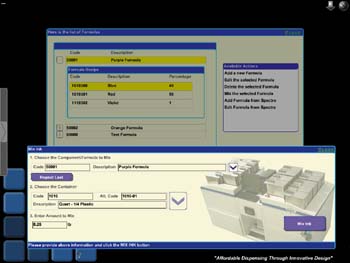Generating proofs that accurately depict the prints you will get from your screen-printing presses is one of the greatest challenges faced by graphics screen shops. This discussion identifies the main goals a color proof should satisfy and provides tips for improving your own proofing results.
With any design file you plan to screen print, you should proof the file prior to production. This is especially important when your customers provide their own files for you to print. The proof should accomplish the following five objectives:
Generating proofs that accurately depict the prints you will get from your screen-printing presses is one of the greatest challenges faced by graphics screen shops. This discussion identifies the main goals a color proof should satisfy and provides tips for improving your own proofing results.
With any design file you plan to screen print, you should proof the file prior to production. This is especially important when your customers provide their own files for you to print. The proof should accomplish the following five objectives:
1. Match the art as the customer wants it reproduced The proof should reflect the way the final job will be delivered to the client. The color, intensity, and texture should be represented in the proof. The ideal situation is to generate a press proof using the actual ink, substrate, and printing conditions that will be used in production. But press proofs are rarely done because they are so expensive and time-consuming to produce. Today, screen shops typically turn to digital proofing systems, including wide-format inkjet printers.
Advertisement
2. Reflect the ink system The key to accurate proofing is a proofing system that uses materials (inks, substrates) that match those you’ll use in production. Many proofs are based on SWOP cyan, yellow, magenta, and black ink standards for offset printing, which are not ideal for screen printing.
3. Reflect the color being used If the color used in the proofing material has a greater reproduction gamut than the screen inks you are using, then the proof will likely always look better than the printed piece because it will contain colors that can’t be reproduced with your screen inks. However, if you measure your printed inks with a colorimeter or spectrophotometer, you can plot the reproduction gamut of the proof in relation to the reproduction gamut of your inks.
If the proof has a smaller gamut than your printing inks, you run the risk of printing an image with noticeable saturated color shifts. This is a real problem when you have subtle, neutral colors (beiges and grays), because they can take on a decidedly chromatic shift. Bright colors will be especially saturated under these conditions. Blues, reds, greens, and purples can appear garish if there is a large difference between the gamut of the proofing ink and printing ink.
4. Reflect the hue error and grayness The two primary indicators of color differences between the proof and the final print are hue error and grayness readings. These values can be obtained by using a color reflection densitometer. The lower the hue error and grayness values, the cleaner and more saturated the colors are. Your proof should match the hue error and grayness value of the printing ink within +/- 2 when both are printed at the same strength.
The hue error and grayness values are influenced by the color of the substrate and the ink density you are using. If the base material of the proof is different than the substrate you will print, the proof will be off. Likewise, the higher the density of the proofing ink, the grayer the color will be. Having higher proof densities than printed ink densities will result in shadow detail being weak and washed out, which reduces contrast and flattens the image.
5. Reflect the dot gain and ink The proof should represent the dot-gain characteristics of your printing process. If you use a photographic proofing system, these systems approximate the physical dot gain (perimeter gain) through the use of higher pigment densities on the proof material, adding optical gain to the image in an attempt to compensate for the physical gain that will occur on press. This approximate gain is usually based on the SWOP anticipated gain of 20%. Unfortunately, any type of dot gain during printing other than a linear 20 percent across the entire tonal range will not be accurate relative to the proof. In screen printing, the typical gain profile calls for dot loss in the highlights and shadows, and dot gain in the midtones. Therefore, built-in gain from a proofing system generally leads to inaccuracy. This is especially true with jobs containing higher halftone line counts.
Advertisement
Viewing conditions
The conditions under which a proof is viewed are also very important. At the very least, the proof should be viewed under 5000°K lighting—the accepted color temperature for color matching. The light source should have a color-rendering index of at least 93, meaning that the bulb you are using has 93% of the full spectrum of daylight illumination.
You should install similar lighting in your press and color-matching areas. If the art department has it, and the customer approves the proof under those conditions, the press operator must be able to duplicate the match in the pressroom under the same lighting. Very critical color matches should be done in a color viewing booth.
Continuity and repeatability
Any proofing system is only as valuable as your production repeatability. If you have a calibrated imagesetter or CTS system and predictable dot gain during production, with a stable set of inks, the proof may turn out well. But if you are like most printers, you change suppliers and inks occasionally and use different mesh counts and different tensions from one job to the next, which makes it very difficult to consistently match proofs.
Ideally, you don’t want to match the proof each time, but have the proof match the final print. Matching the proof is highly subjective and up to the skill of the press operator. Generating a proof that matches the press’s performance removes a great deal of the guesswork and leads to repeatable images.
No proofing system will be valid if you change your production parameters without changing the proofing system. Likewise, if your printing system is not perfectly repeatable, the proof will fail. By standardizing your production methods and profiling the color-rendering capabilities of your printing system, you’ll be able to adjust the proofing process accordingly and generate proofs that accurately reflect the prints coming off your press.
See also: 12 Tips for Color Matching
Advertisement


 Case Studies2 months ago
Case Studies2 months ago
 Art, Ad, or Alchemy2 months ago
Art, Ad, or Alchemy2 months ago
 Andy MacDougall2 months ago
Andy MacDougall2 months ago
 Columns3 weeks ago
Columns3 weeks ago
 Editor's Note3 weeks ago
Editor's Note3 weeks ago
 Marshall Atkinson3 weeks ago
Marshall Atkinson3 weeks ago
 Thomas Trimingham2 months ago
Thomas Trimingham2 months ago
 News & Trends2 months ago
News & Trends2 months ago
















